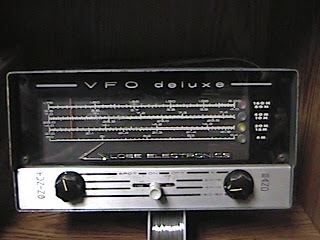I still need these two QSL cards to complete the 13 Colonies special event for 2015.
Of course, it's kind of ironic that one of the two QSL cards that I need would be from the state that I live in - and that my original QSL request was sent to a town just two over from home. I guess I will have to re-send QSL requests to both New Jersey and Delaware. However, instead of mailing the NJ one, I might just drop it off at the manager's mail box. He lives not far off the route I take to get back and forth from work every day. That way I'd be 1000% sure that he received it.
I've been e-mailing back and forth with my good friend Bob W3BBO. At a recent hamfest, he picked up these:
Yes, this is a Heathkit DX-60 and the accompanying HG-10 VFO. Well actually, he picked up the DX-60 at the hamfest. A friend supplied the HG-10 and advised Bob that it needed some TLC, and that if he could get it working, that he could purchase it at a super reasonable price. Bob has succeeded in getting it to work and he e-mailed me this morning that he is in the process of homebrewing a cable to get the output of the VFO into the DX-60.
That reminded me of a much earlier time, when I had these in my Novice station.
My Novice transmitter was a Drake 2-NT that I had purchased through Burghardt Electronics. I had purchased the Globe V-10 VFO from John Kakstys W2FNT who lived in Linden, NJ which was not too terribly far from East Brunswick, where I was living at the time. My receiver was the Heathkit HR-1680, which was my very first Heathkit build. That it worked without a hitch the very first time, upon firing it up, still amazes me to this day.
Anyway, I had the transmitter and I had the VFO. What do I do with them? That was the quandary for me at the time. This was 1979, after all. There was no Internet, no Google. I had no Elmer with whom I could speak, other than the instructor who taught the license class I had attended (and I never got his home telephone number). So it was either get the information I needed from a book, QST or go with my gut and improvise.
I improvised. There was a two conductor cable coming from the output of the VFO. The 2-NT's crystal socket had two holes for where you would plug in a crystal. I figured that the output from the VFO had to go there - it just seemed reasonable to me. So I took a junk crystal, pried the bottom part off, which left me with a base and pins. Then I soldered the two wires coming from the VFO output to the crystal base pins. I plugged it in, hoping the 2-NT wouldn't know the difference between a crystal and a VFO. I took a deep breath, muttered a prayer and turned everything on. I half expected it to blow up, taking me along with it, or to somehow electrocute me.
It didn't.
I connected the 2-NT to a dummy load and adjusted it for the lowest output power I could (see, QRP even way back then, I just didn't know it yet!). Then I turned on the HR-1680 and keyed the 2-NT to see if I could hear anything.
It worked!
I had successfully hooked up my VFO to my transmitter and did not harm myself or anyone else in the process. Much to my parent's delight, I didn't burn down the house, either! I used that setup for a lot of QSOs and enjoyed the heck out of it. After I upgraded to General and bought some equipment capable of doing SSB (silly boy), instead of selling off my Novice station, I donated it to the Handi-Hams, who were pretty much a new organization back then. I guess they must have been desperate for equipment donations at the time, as they gratefully accepted it - homebrewed VFO cable patch job and all.
72 de Larry W2LJ
QRP - When you care to send the very least!







No comments:
Post a Comment